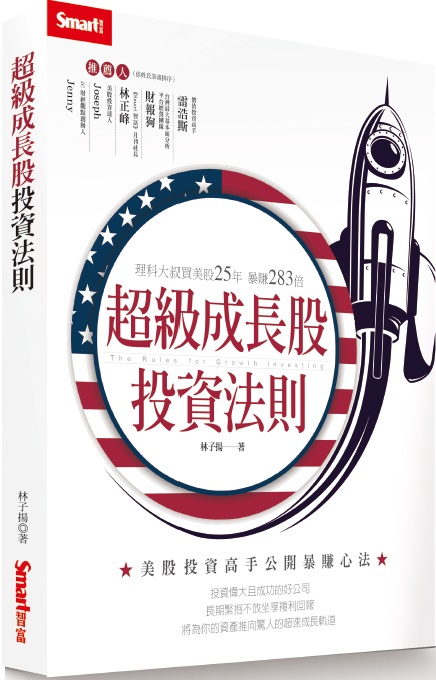In this article, here is a list of investor’s must-have, Andy’s free tools developed for US stock investment.
“The Rules of Super Growth Stocks Investing”, my first US stock book, ship worldwide, free shipping to Taiwan
“The Rules of Super Growth Stocks Investing《超級成長股投資法則》” has been published in April 2021. The English title is “The Rules of Super Growth Stocks Investing”. Click here to immediately view the flip-book video of the new book “The Rules of Investing in Super Growth Stocks”. Where to place my order? Please click the link “The Rules … Continue reading ““The Rules of Super Growth Stocks Investing”, my first US stock book, ship worldwide, free shipping to Taiwan”
The reasons for Nvidia’s monopoly and the challenges it faces
Nvidia will continue to focus on the field of artificial intelligence chips
Follow Andy Lin’s long-term investment at US stocks Facebook, Twitter and LinkedIn
We need facebook Facebook has always been the social network with the widest audience because Facebook is so ubiquitous and convenient. For a long time, some friends have hoped that this blog can have a Facebook communication channel. Facebook Group After many years of trying, I established a Facebook group called “Andy Lin’s Facebook group … Continue reading “Follow Andy Lin’s long-term investment at US stocks Facebook, Twitter and LinkedIn”
Articles set for US stock dummies: resources, tools, books investors must have, ETF tracking broader market, how to trade US stocks?
US stock resources, tools, and books investors must have
New book releases “The Rules of 10 Baggers”, ship worldwide, free shipping to Taiwan
The Rules of 10 Baggers
How great Norway Sovereign Wealth Fund (GPF) is?
Norway Sovereign Wealth Fund, or Norwegian Government Pension Fund (aka Government Pension Fund: GPF) is well-known among most people with investment experience. The Norwegian sovereign wealth fund is very important. It is the most important sovereign wealth fund and pension fund in the world. Norway Sovereign Wealth Fund (GPF) worth learning from investors
Startup issues that most people care about
With the development of the capital market in recent years, companies do not necessarily need to be listed, and there are many factors that can hinder startup companies from going public.
Top vendors and uses of GPU
2006, Hinton and his student Simon Osindero published an important paper “A Fast Learning Algorithm for Deep Belief Nets” recommends using GPU to increase the speed of training neural networks.
Why China and Russia immune from global IT crash? Why does it happen? What is the impact?
A serious error in the CrowdStrike security software caused automatic updates to be pushed to computers and terminal devices using Microsoft Windows systems around the world, causing computers and terminal devices to crash. Global IT crash happen!
How much does generative AI cost?
A few days ago, I published a post “Why software underperforming amid the AI craze?”, Today’s article lists some practical examples and figures for your reference, so that readers can have an idea of generative AI cost.
Bank of America, too big to fall
Bank of America (ticker: BAC) was formed in 1998 through the merger of NationsBank and Bank of America. It is the second largest banking institution in the United States and the second largest bank in the world by market capitalization. Both are second only to JPMorgan Chase. Bank of America is one of the four largest banking institutions in the United States.
How much potential does ARM’s WOA (Windows on ARM) has?
On June 3, 2024, after ARM CEO Rene Haas gave a speech at Computex in Taipei, he publicly stated in an interview with the media that the company’s goal is to have ARM’s Windows on ARM PC could obtain more than 50% of the Windows PC market within five years. % share.
A brief discussion on partnership
In addition to venture capital firms, accounting firms, law firms, consulting firms, private equity funds, investment banks, and wealth asset managers; these types of large companies are usually partnerships──unless they are companies To go public, it will be reorganized into a limited company.
How low-key Marvell makes money?
Marvell was the sixth largest professional semiconductor designer in the world by revenue at the end of 2023.
Mong-Song Liang, the hero of SMIC’s breakthrough in US blockade
Almost all Taiwan’s media circles label Mong-Song Liang a traitor, which I really disagree with. History will give Mong-Song Liang a fair justice. He is the biggest contributor of Samsung’s 14nm, SMIC’s 20nm, 14nm, 7nm, 5nm and beyond
Top five semiconductor equipment providers
In Q1 2024, the revenue of top five semiconductor equipment providers decreased by 9% year-on-year















